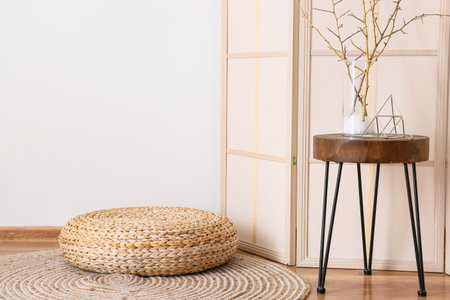1. Introduction: The Unique Charm of British Heritage Interiors
The interiors of historic British homes have long been celebrated for their unique character and distinctive atmosphere. When you step into a traditional British property—whether a Georgian townhouse, a Victorian terrace, or an Edwardian semi—you are immediately greeted by period features such as ornate mouldings, grand fireplaces, and the gentle patina of timeworn timber floors. These architectural details do far more than simply decorate a space; they serve as living reminders of the UK’s rich history, craftsmanship, and cultural heritage. In British culture, these interiors evoke a sense of continuity and belonging, connecting people to generations past and the stories embedded within the walls. The preservation of such features is often approached with reverence, not only for their aesthetic appeal but also for the way they foster a feeling of homeliness and wellbeing. This enduring appreciation reveals why historic interiors continue to hold such significance in the UK today, even as contemporary design trends evolve.
2. Modern Minimalism: Principles and Appeal
Modern minimalism has established itself as a defining trend in British interiors, standing in distinct contrast to the ornate and layered designs of historic periods. At its core, minimalism is about stripping back to essentials—creating spaces that are uncluttered, functional, and visually calm. This approach resonates strongly with contemporary British society, where urban living often means smaller homes and fast-paced lifestyles. Minimalist interiors provide a sense of respite from daily overstimulation, promoting wellbeing through thoughtful simplicity.
Key Principles of Modern Minimalism
| Principle | Description | Contrast with Historic Styles |
|---|---|---|
| Simplicity | Focus on clean lines, open spaces, and a restrained colour palette. | Historic interiors often featured intricate mouldings, patterns, and rich ornamentation. |
| Functionality | Every item serves a purpose; decorative objects are limited. | Historic styles embraced decorative elements for their own sake, such as gilded frames or elaborate drapery. |
| Natural Light | Maximising light with large windows and sheer treatments. | Older homes typically used heavy curtains and smaller window panes. |
| Calm Atmosphere | Aim to reduce visual noise for mental clarity and relaxation. | Historic interiors sometimes prioritised grandeur over tranquillity, resulting in busy spaces. |
The Appeal of Minimalism in Contemporary Britain
Modern British homeowners are increasingly drawn to minimalism for both aesthetic and practical reasons. With housing trends leaning towards compact living—especially in cities like London, Manchester, and Edinburgh—the minimalist ethos fits naturally into everyday life. It allows residents to maximise available space while cultivating an environment conducive to relaxation and focus. Furthermore, the neutral tones and streamlined furnishings characteristic of this style make it easier to personalise spaces with meaningful pieces rather than clutter.
Cultural Shifts Supporting Minimalism
The popularity of minimalism also reflects wider societal shifts in Britain. There is growing awareness of environmental sustainability, prompting people to choose quality over quantity when furnishing their homes. Mindfulness practices have gained traction too, aligning with minimalist principles by emphasising intentionality and presence in one’s surroundings.
A Harmonious Counterpoint to Tradition
While historic British interiors celebrate heritage through layers of detail and history-rich décor, modern minimalism offers a refreshing counterbalance. The two approaches may seem at odds, but together they invite a dialogue between past and present—a theme explored further in this article as we consider how blending these styles can foster wellbeing in contemporary British homes.

3. Striking a Balance: Combining Old and New
Achieving harmony between historic British interiors and modern minimalism is both a creative challenge and an opportunity for innovation. The key lies in respecting period features—such as ornate cornicing, original fireplaces, and sash windows—while introducing minimalist principles that prioritise functionality and mental wellbeing. Start by identifying architectural elements worth preserving; these often become focal points around which the rest of the space can be designed.
Practical Approaches
Begin with a neutral colour palette that highlights existing craftsmanship without overwhelming it. Soft whites, muted greys, and earthy tones work well in Victorian terraces or Georgian townhouses, allowing original details to take centre stage. Where possible, restore rather than replace: sand back wooden floors, polish brass hardware, and expose brickwork for authentic character. Integrate built-in storage solutions to reduce visual clutter—think recessed shelving within alcoves or under-stair cupboards that keep spaces streamlined yet functional.
Aesthetic Strategies
Balance is also achieved by layering textures thoughtfully. In a traditional setting with high ceilings and decorative mouldings, introduce minimalist furnishings with clean lines in natural materials like oak, linen, or wool. Select contemporary lighting—such as understated pendant lamps or LED strips—to subtly illuminate period features instead of competing with them. Art curation offers another bridge between eras: display abstract pieces in antique frames or lean modern prints on classic mantelpieces for an eclectic yet cohesive look.
Respecting Heritage While Embracing Simplicity
The most successful blends celebrate contrasts rather than hiding them. Allow the quirks of a listed cottage or Edwardian flat to inform your design choices, but pare back excess ornamentation elsewhere to avoid sensory overload. Opt for quality over quantity when it comes to decor—each piece should have purpose and presence. This mindful approach not only preserves the historical soul of your home but also fosters a calming environment aligned with modern wellbeing ideals.
4. Wellbeing at Home: Psychological Impacts of Interior Design
In recent years, UK-based studies and thought leaders have increasingly emphasised the connection between interior design and wellbeing. A balanced approach, marrying historic British interiors with modern minimalism, has shown promise in fostering mental health, relaxation, and productivity within the home environment.
The Psychological Effects of Interior Space
The historical features found in many British homes—such as ornate cornices, sash windows, and period fireplaces—can evoke a sense of continuity and comfort. Meanwhile, the uncluttered aesthetic of minimalism encourages calmness and focus. According to research from the University of Reading and the UK Mental Health Foundation, environments that blend these elements provide both visual interest and restorative simplicity.
Balanced Interiors: Key Factors for Wellbeing
| Design Element | Historic Feature | Minimalist Feature | Psychological Impact |
|---|---|---|---|
| Colour Palette | Deep greens, navy blues | Soft neutrals, whites | Encourages tranquillity, reduces stress |
| Texture & Materials | Natural woods, stone fireplaces | Smooth surfaces, glass accents | Offers sensory grounding and clarity |
| Lighting | Leaded windows, statement chandeliers | Recessed lighting, open spaces | Supports mood regulation and productivity |
| Furniture Arrangement | Cosy nooks, traditional layouts | Open-plan living, multi-use zones | Cultivates comfort and flexibility for daily routines |
UK Perspectives: Creating a Supportive Home Environment
The NHS and UK-based interior designers alike highlight the role of personalisation in promoting wellbeing. By integrating heritage elements with minimalist organisation, homeowners can create spaces that reflect their identity while avoiding overstimulation or clutter. This approach has been shown to support mental health by reducing anxiety and boosting feelings of control.
A Practical Note on Adaptation for British Homes
The unique architectural features common in the UK—such as Victorian terraces or Georgian townhouses—offer an ideal canvas for this balance. By retaining period details while embracing modern functionality and pared-back styling, residents can enjoy a home environment that nurtures both tradition and psychological wellness.
5. Case Studies: British Homes Successfully Navigating the Blend
Across the UK, an increasing number of homeowners are embracing the challenge of integrating historic British interiors with the clarity of modern minimalism. This approach not only preserves heritage but also supports contemporary wellbeing. To illustrate, let’s consider several distinctive examples that demonstrate how this blend can be achieved with both respect and creativity.
London Terraces: Victorian Foundations, Contemporary Calm
In many London terraced houses, original features such as cornicing, ceiling roses, and ornate fireplaces are sensitively retained. Homeowners often choose a restrained palette—think chalky whites or soft greys—to allow these details to shine while avoiding visual clutter. By selecting streamlined furnishings and discreet storage solutions, these spaces maintain historical character yet feel fresh and uncluttered. Large sash windows, left unadorned or dressed with simple linen blinds, maximise light and create an airy sense of space—a key tenet of modern minimalism.
Cotswold Cottages: Rustic Charm Meets Clean Lines
The honeyed stone walls and exposed beams typical of Cotswold cottages provide a rich backdrop for minimalist intervention. Here, success often lies in contrast: traditional flagstone floors are paired with low-profile furniture in natural woods or muted textiles. Decorative elements are sparingly chosen—perhaps a single oversized ceramic jug or a hand-thrown bowl—emphasising quality over quantity. Open-plan layouts, where possible, help small rooms feel less confined while keeping the cottage’s inherent warmth intact.
Georgian Townhouses: Period Grandeur with Subtle Restraint
Georgian homes are renowned for their proportions and architectural flourishes. In successful renovations, owners highlight these assets by painting panelling in neutral tones and choosing minimalist lighting fixtures—often favouring matte brass or frosted glass. Kitchens and bathrooms are kept sleek and functional, with shaker-style cabinetry offering a nod to tradition without excess ornamentation. The overall effect is one of understated elegance: historic bones celebrated within a purposeful, uncluttered environment.
Key Takeaways from Real-World Examples
- Preserve irreplaceable historic details wherever possible—they provide unique character.
- Simplify colour schemes to give architectural features room to breathe.
- Opt for high-quality materials and finishes that bridge old and new aesthetics.
- Embrace negative space; not every surface needs decoration.
Conclusion
The British approach to blending history with minimalism is not about erasing the past but elevating it through mindful design choices. These case studies underscore that balance is attainable—and that wellbeing can flourish in homes where both heritage and simplicity coexist harmoniously.
6. Practical Tips for UK Homeowners
Achieving a well-balanced interior that honours both historic British charm and modern minimalism is not just a question of style—it’s about thoughtful decisions rooted in local context. Here are some practical tips for homeowners across the UK:
Champion Local Craftsmanship
Seek out British artisans and craftspeople when sourcing furniture or decorative items. Whether it’s hand-thrown pottery from Stoke-on-Trent or bespoke joinery from Yorkshire, incorporating locally made pieces brings authenticity and supports regional skills. This approach also helps retain the unique character often found in historic homes.
Source Materials Responsibly
Opt for sustainable, locally sourced materials whenever possible. Reclaimed wood beams, Welsh slate, or Scottish wool textiles can bridge the gap between heritage aesthetics and contemporary needs. These choices not only reduce environmental impact but also echo the long-standing British tradition of using what’s available nearby.
Everyday Functionality
Minimalism isn’t about austerity—it’s about clarity and calm. Select multi-functional furnishings that complement period features without overwhelming them. For example, a simple oak dining table pairs beautifully with Victorian cornicing, while built-in cabinetry respects both modern storage needs and Georgian proportions.
Embrace Subtle Colour Palettes
Draw inspiration from classic British interiors by working with muted, earthy tones—think Farrow & Ball greys, mossy greens, or chalky whites. These hues provide a serene backdrop that allows architectural details to shine while supporting a minimalist sensibility.
Balance Old and New Thoughtfully
Don’t be afraid to juxtapose clean-lined lighting with an ornate ceiling rose or place abstract artwork above a traditional mantelpiece. The key is restraint: let each element breathe so neither history nor modernity dominates.
Consider Everyday Living
Finally, remember that your home should serve your daily wellbeing. Create spaces for quiet reflection as well as social gathering—perhaps a reading nook by a sash window or an open-plan kitchen with views to the garden. By blending the best of Britain’s design legacy with mindful minimalism, you can create an interior that feels both rooted and refreshing.

